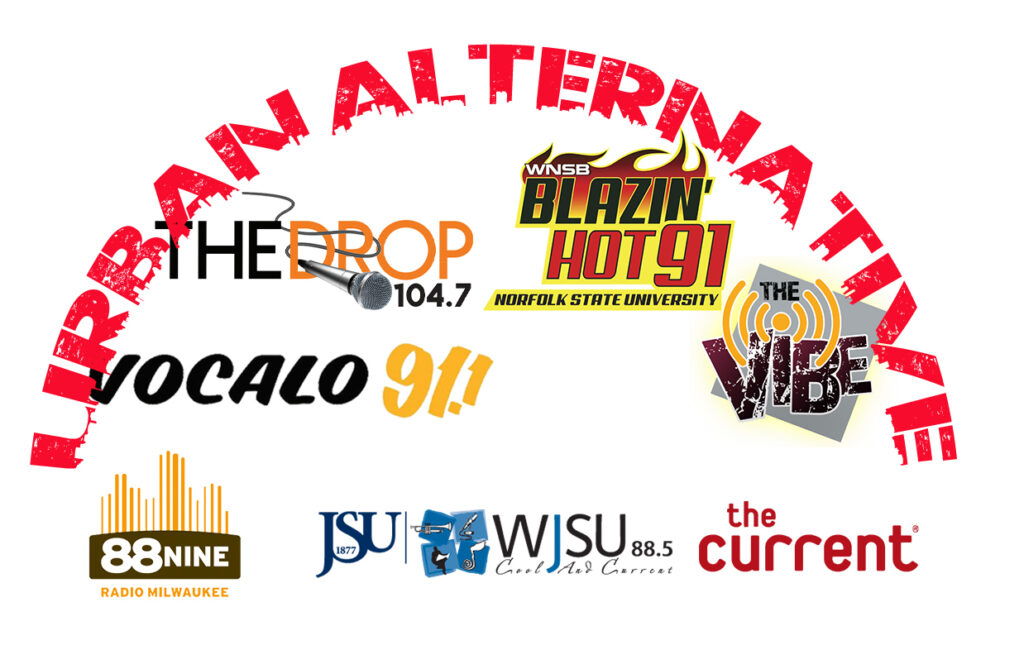Public radio’s unconventional effort to lure young and diverse audiences to the left end of the radio dial continues with audience growth and the addition of three new stations.
The local audiences for the first four Urban Alternative (UA) stations in Chicago, Denver, Norfolk, and Houston continue to expand. The Corporation for Public Broadcasting (CPB) provided start-up funding for each of these stations, and today I presented the results on the panel “Urban Alternative Redefines Public Radio” at the Public Radio Program Directors Conference, which has featured the UA format for three years in a row:
 “104.7 THE DROP” in Denver (KUVO HD2), which launched in February on FM after being a stream-only channel for less than two years, has already seen its audience reach 70,000 listeners and is ranked 13th among 25-34 year-olds, its target demo.
“104.7 THE DROP” in Denver (KUVO HD2), which launched in February on FM after being a stream-only channel for less than two years, has already seen its audience reach 70,000 listeners and is ranked 13th among 25-34 year-olds, its target demo.- Chicago’s “Vocalo” (WBEW-FM) now registers enough listeners to register in the monthly Nielsen ratings and reaches up to 50,000 listeners a month, which it had never achieved prior to adopting the new UA format.
- “Blazin’ Hot 91” WNSB in Norfolk shot out of the gate with a 2.0 Share 6+ within four months of launching and reaches more than 80,000 listeners in some months.
- “The Vibe” in Houston, which airs during nights and overnights while Jazz airs during the day, registers over 180,000 listeners in the most recent (August 2021) Nielsen ratings.
The performance of the first four UA stations bears out Paragon’s market research in each city that showed us great potential for the new format. The UA format is more than a small niche, but rather is a viable, mainstream format that does bring young and diverse audiences into public radio. This is a major feat for public radio, which for decades has built audiences from content aimed at older, highly educated, upper income, non-ethnic (White) listeners.
CPB’s Vice President of Radio, Jacquie Gales Webb, joined the PRPD panel to announce the next three public media companies that will receive CPB funding to start local UA stations. This is from the CPB press release:
- Radio Milwaukee will provide an eclectic radio experience that serves all of Milwaukee’s constituents, celebrates the spectrum of Black music, provides opportunities for audiences to discover authentic DJs and local musicians and amplifies the power of community-centric public radio. Radio Milwaukee will use a multi-platform content strategy that includes some FM broadcast, a dedicated 24-hour digital channel and multiple streaming platforms, including smart speakers and the station’s website and mobile app.
- WJSU, a public radio station licensed to Jackson State, a historically Black university in Jackson, Mississippi, will refresh its programming to reflect the changing interests of students and younger listeners, provide a path to long-term sustainability, and increase community collaborations and digital engagement. WJSU will also pursue a multi-platform strategy including some FM broadcast, a dedicated 24-hour digital channel and a mobile app.
- Minnesota Public Radio will collaborate with KMOJ, a community-licensed public radio station that focuses on Minneapolis’ communities of color, to amplify the format’s reach, cultivate new talent, create engagement opportunities, and develop co-branded content to be shared across airwaves and digital platforms. MPR will launch the format across its streaming service, broadcast and HD2 channels, and smartphone App.
As I said on the panel, the growing UA family of stations is about to have three new babies. Listeners in Minneapolis, Jackson and Milwaukee are beneficiaries of CPB’s visionary funding and their bold local public radio stations that dare to be different.
Learn more about Mike.

Leave A Comment